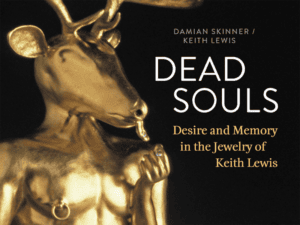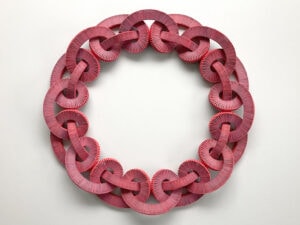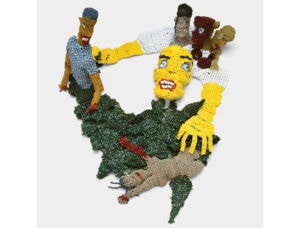Hoping to get some idea of the ramifications of fine art’s turn to the handmade, I started reading By Hand: The Use of Craft in Contemporary Art, edited by Shu Hung and Joseph Magliaro. As the editors write in their preface:
Hoping to get some idea of the ramifications of fine art’s turn to the handmade, I started reading By Hand: The Use of Craft in Contemporary Art, edited by Shu Hung and Joseph Magliaro. As the editors write in their preface:
‘The idea for By Hand came from noticing that a growing number of contemporary artists are producing work with their hands, using methods and materials traditionally associated with craft. These renegades replace the paintbrush with a needle and thread and, instead of standing in front of a canvas all day, spend time hunched over sewing machines and embroidery hoops. Activities historically associated with feminine conventions are stunningly repurposed and, as a result, become disassociated from their quotidian contexts.’
The references to sewing and embroidery indicates the focus of this book, which is really a collection of artists using textile techniques and materials, with a few who carve wood and make limited edition artist books thrown into the mix. Which means that, through no fault of the authors, this book is not particularly interesting from a jewelry perspective, as the objects that are created by these artists don’t tend to have much to do with the kind of objects created by contemporary jewelers.
I was disappointed by this book, because it just sidestepped the issue I most wanted to find out about. As the authors write: ‘In making this book we are not attempting to tackle the distinctions between art and design, art and craft, and craft and design. That might require another publication entirely. By Hand instead seeks to present a lively and diverse roster of contemporary creative artists who employ methods of hand production in their work.’
I think this is a mistake. In avoiding what they legitimately suggest is a thorny and confusing issue, the editors are unable to locate the artistic practices featured in the book in terms of all the various contexts and histories which might generate meaning around these objects. For example, they observe:
‘The participants profiled in this book all share a dedication to materials and processes.’
‘Art is engaged as a process rather than as a means to an end, and there is a palpable sense of attachment to the materials and methods that are employed.’
‘Although the handmade quality of this work alludes to notions of practicality and functionality, it does not exclude an abundance of ideas and original thinking.’
While these might be original thoughts in relation to fine art, they don’t offer much to contemporary thinking about what craft is, or what it does, beyond stating the obvious. How would these practices look from a craft perspective? How might they challenge, disrupt, confirm or redirect contemporary craft? Which, I think, reveals that this book is assembled from the dominant position of fine art, where you can afford to avoid the issue of art and craft because you don’t have to worry about it. After all, the art world can pluck whomever it wants from the craft world, knowing that the lucky immigrant will be grateful and envied by all the rest who don’t get to cross the border. (The Introduction talks about a 2004 exhibition called Boys Who Sew, curated by Janice Jeffries at the Crafts Council of Great Britain, in which she brought together international artists who use needle and thread in their work. According to the authors, ‘Jeffries goes on to situate this new artistic movement outside of the traditional confines of art, craft and design,’ yet the authors don’t bother to tell us what this means, or how this new categorization is achieved, or whether craftspeople will be invited to sit at the table. Presumably, we are still waiting for the companion show at the Tate Modern, in which craftspeople using needle and thread get integrated into the discourse of fine art.)
Actually, it might just be that this lack of focus is a result of the quality of thinking behind the book, rather than a refusal to tackle the question of cultural politics that come with fine art’s current love of the handmade. The introduction is five pages long and doesn’t gather much intellectual speed. We are told that the interest in the handmade is a rebellion against ‘the ubiquity and singularity of mass production and digital technology’ and ‘The emergence of handmade and craft-related practices is, in a sense, a response to the omnipresence of technology in everyday life and in artistic procedures.’ The internet has inspired a generation with a DIY philosophy, hence the desire to get in and make things, often using ‘age-old techniques, often passed down from one generation to another . . .’ The fact that these artists live in cities around the globe tells us that ‘the handmade movement is not confined to certain countries,’ although there is no discussion of whether, or how, regional differences might play out in the work. And: ‘Although some choose to focus thematically on issues of gender, as a whole, they assert that men and women are capable of knitting, crocheting, sewing, and producing handmade work.’ Not a particularly profound insight, given that any visitor to a museum with a decent collection of material culture would be able to discover the same thing for themselves.
Still, it does point to where the power of craft in the contemporary world resides. As the preface of By Hand concludes, these artists ‘are happy to leave their fingerprints on their work in an attempt to get closer to their own lives and to the lives of others.’ This is what craft practices such as jewelry already do. Objects like brooches, necklaces and rings are able to ingratiate and insinuate themselves into people’s lives and their biographical narratives in a way that is unparalleled by fine art. It’s nice to think that jewelry does what fine art wishes it could and it doesn’t even have to try.





